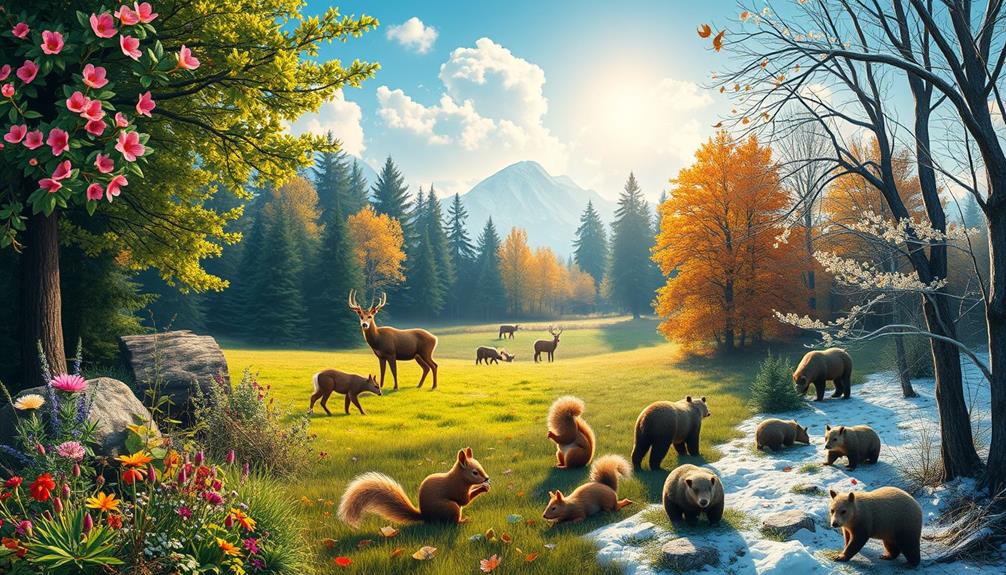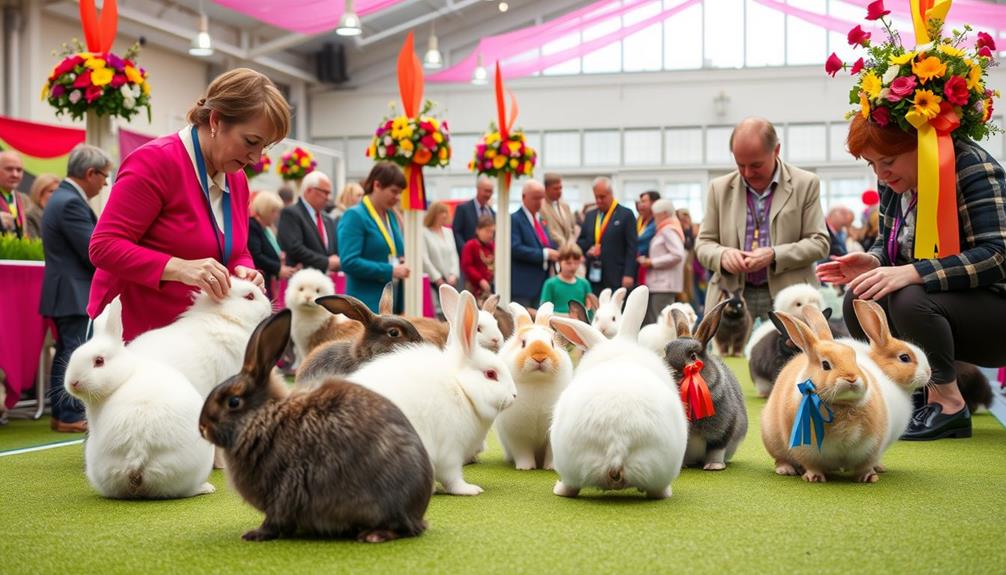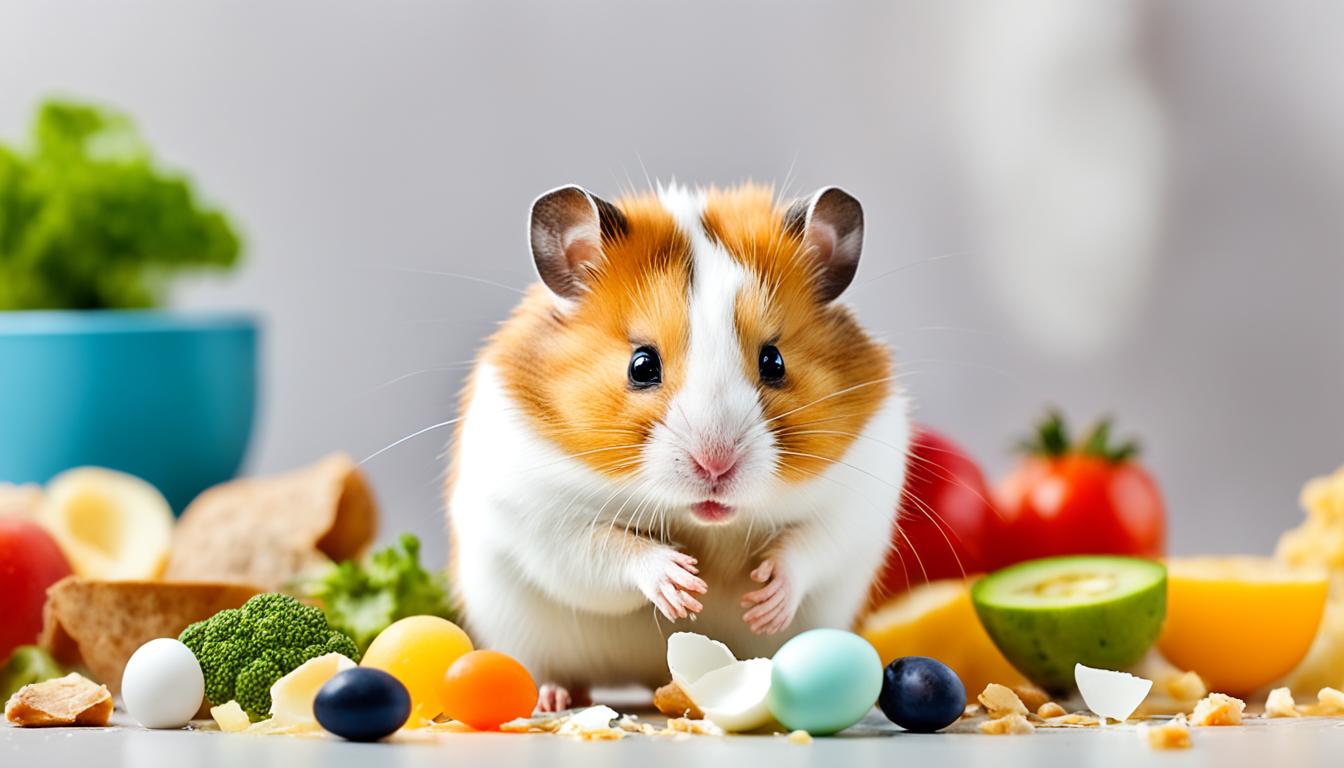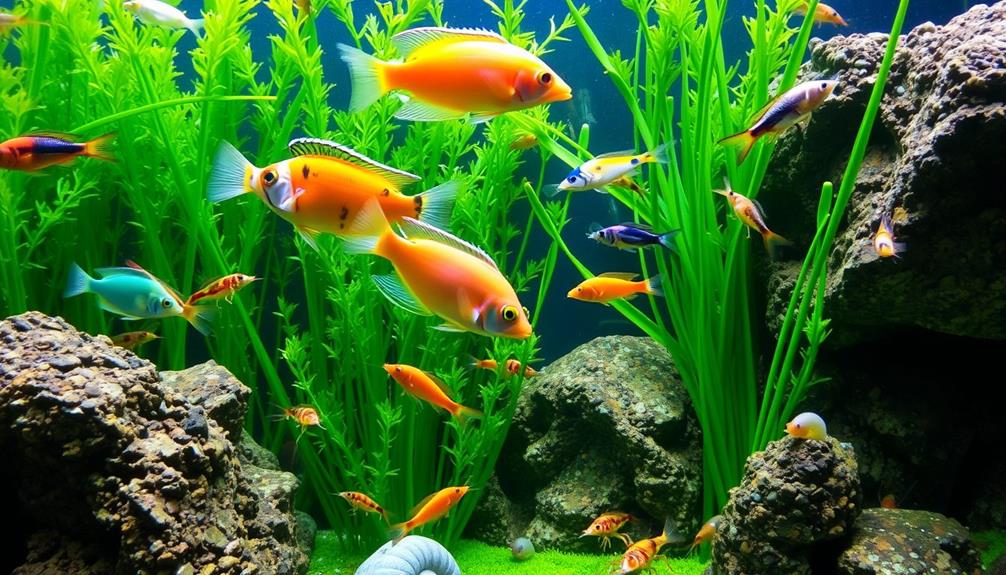Seasonal changes can greatly impact animal behavior, and you'll notice a variety of adaptations in the wild. For instance, many birds time their migrations based on food availability and temperature shifts. Hibernators, like groundhogs, prepare for winter by lowering their metabolic rates, while others, like spadefoot toads, breed during the rainy season for survival. Animals might also change their coats for camouflage and insulation. As climate affects these patterns, you might see disruptions in breeding and migration. Stick around to discover more about these fascinating adaptations and the implications of changing seasons on wildlife.
Key Takeaways
- Many animals time their reproduction based on environmental cues like temperature and daylight, affecting their breeding success.
- Hibernators enter a state of dormancy at specific temperatures, often giving birth in early spring to align with food availability.
- Climate change disrupts migratory patterns, causing earlier arrivals at breeding grounds and misalignment with food resources.
- Adaptations such as changing coat colors help mammals survive seasonal temperature variations and enhance camouflage.
- Monitoring animal behavior changes is crucial for conservation efforts and understanding the impacts of climate change on ecosystems.
Timing of Birth
The arrival of spring brings a burst of life as many young mammals are born, a timing that guarantees their survival. This strategic timing of birth aligns with increased food availability, essential for the young's growth and health.
Seasonal awareness plays a critical role in reproduction, as animals must respond to environmental cues to make certain their young thrive. Understanding the emotional dynamics faced by mothers, such as those with BPD push-pull dynamics, can also shed light on maternal behaviors in the animal kingdom, emphasizing the importance of stability for offspring.
For instance, house sparrows kick off their breeding season in early March, instinctively recognizing the lengthening days as a signal for ideal conditions.
Similarly, garter snakes emerge from hibernation to mate when temperatures rise to between 20-28°C (68-82°F), highlighting how temperature cues directly influence reproduction.
Even amphibians like spadefoot toads time their breeding with the monsoon season, waiting for heavy rainfall to create a conducive environment for their offspring.
By syncing their reproductive cycles with favorable conditions, these animals enhance their chances of survival.
Understanding the timing of birth in relation to seasonal changes can deepen your appreciation for the intricate strategies animals use to navigate their environments and guarantee the continuation of their species.
Solar Influence on Breeding

Many animals rely on solar cues to time their breeding seasons, ensuring their offspring arrive when resources are plentiful. For example, house sparrows typically begin their breeding season in early March, responding to the increasing length of the day. This synchronization with solar influences can also be reflected in how animals optimize their health during this period, similar to holistic lifestyle approaches that alleviate various health issues.
As the days grow longer, these animals experience hormonal changes that trigger reproductive behaviors, making the timing essential for their survival.
You might notice male house sparrows undergo noticeable physical changes, such as a brightening of their beak color, signaling their readiness to mate. This solar influence creates a synchronized wave of breeding activity among various species, aligning their reproductive cycles with the availability of food.
As summer approaches and the days begin to shorten, breeding behaviors in house sparrows and other animals generally come to an end.
Temperature Cues for Hibernators

Temperature cues play an essential role in the lives of hibernators, signaling when to emerge from their winter slumber. For instance, garter snakes begin to wake up as temperatures rise to about 20-28°C (68-82°F) in spring. This increase not only marks the end of hibernation but also kicks off their breeding season.
The timing of hibernation and emergence is influenced by environmental factors, similar to how divorce proceedings unfold in response to personal circumstances. When temperatures drop to 0°C (32°F), these snakes enter hibernation, markedly reducing their metabolic rate.
The timing of hibernation and emergence is vital for reproductive success. After awakening, snakes must breed shortly to guarantee their young are born when conditions are most favorable. Temperature changes act as reliable environmental cues, guiding hibernators on when to wake and when to breed.
You'll notice that different species show varying hibernation strategies based on their specific environmental conditions and temperature ranges. This diversity affects their emergence and breeding patterns, ensuring that each species adapts to its unique habitat.
Understanding these temperature cues helps you appreciate the intricate connections between climate and animal behavior in nature.
Monsoon Breeding Strategies

When the monsoon rains arrive, spadefoot toads spring into action, timing their breeding events to maximize survival. This remarkable adaptability showcases how curiosity in environmental cues can enhance their reproductive success curiosity enhances problem-solving abilities.
You'll see them emerge from their burrows as environmental conditions shift, taking advantage of the food-rich pools formed by the rain. This strategic timing not only helps their offspring thrive but also enhances their chances of survival in a challenging desert landscape.
Timing of Breeding Events
In the unpredictable desert environment, spadefoot toads have developed a remarkable strategy to time their breeding events with the monsoon season. By responding to environmental cues, like increased moisture, these toads know when conditions are right for reproduction.
This adaptability is akin to how certain zodiac signs may be viewed regarding attractiveness, as they too respond to their environments, enhancing their overall allure astrological compatibility can affect relationships. They stay underground, waiting for the perfect moment to emerge and breed during brief periods of mild weather, when food is plentiful.
This timing of breeding events is essential. When the rains come, the temporary ponds provide a safe haven for their eggs and tadpoles, ensuring a higher survival rate for the toadlets.
After the breeding frenzy, the young toads instinctively dig underground as the desert dries up, avoiding harsh conditions and predators.
This strategy highlights how important it's for these creatures to synchronize their reproductive efforts with environmental changes. By aligning their breeding with the monsoon, spadefoot toads enhance the success of the next generation.
This remarkable adaptability illustrates how animals can thrive in challenging conditions, and it's a reminder of the intricate relationships between behavior and the environment.
Environmental Conditions Impact
Environmental conditions play an essential role in the survival and reproductive success of spadefoot toads.
These fascinating creatures emerge from their underground burrows primarily during the monsoon season when heavy rainfall creates a favorable environment. They time their breeding to coincide with brief periods of mild weather, ensuring ideal conditions for their offspring. This strategy is critical because it maximizes the availability of food resources, which are necessary for the developing young toads.
Additionally, understanding the importance of a balanced diet in their ecosystem can help highlight how these toads adapt to their environment. As soon as the rain falls, the toads take advantage of the abundant food supply, such as insects, that thrive in wet conditions. This abundance allows them to breed successfully, increasing the chances of their offspring's survival.
After the rains subside and the desert dries up, the young toadlets dig underground to escape harsh conditions, relying on the moisture retained in the soil.
Survival of Offspring
The survival of spadefoot toad offspring hinges on their unique monsoon breeding strategies. These toads emerge from underground burrows in response to heavy rainfall, taking advantage of the environmental cues that signal the perfect time for breeding. The brief intervals of mild weather and increased food availability during the monsoon season guarantee a higher survival rate for their young.
Here's how their breeding strategies align with seasonal changes:
| Strategy | Benefit | Timing |
|---|---|---|
| Breeding after rain | Increases food availability | Monsoon season |
| Underground development | Protects from drying conditions | Post-breeding |
| Synchronization | Enhances reproductive success | Environmental cues |
Understanding these strategies highlights the significance of timing in the animal kingdom. When the desert dries up, toadlets dig underground, utilizing the moisture-rich environment for their early development. This strategic timing is vital, as food scarcity can severely impact their survival. By relying on specific environmental cues, spadefoot toads effectively synchronize their life cycles with seasonal changes, maximizing the chances of raising healthy offspring.
Environmental Cues and Reproduction
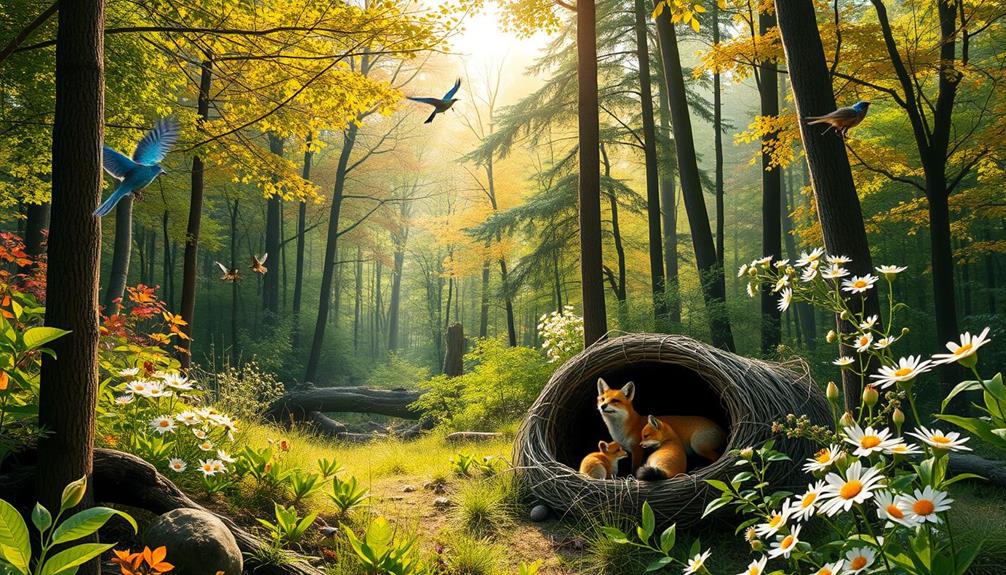
You'll notice that many animals time their reproduction based on environmental cues, like temperature and daylight changes.
These factors not only influence when they mate but also guarantee their offspring have access to ample food.
For instance, the seasonal changes in temperature can also affect the availability of resources, similar to how geothermal energy utilizes the earth's internal heat to provide reliable energy sources.
Understanding this connection is essential for conserving species, as any disruption can impact their reproductive success.
Timing of Reproduction
Reproduction in animals is intricately linked to seasonal changes, with many species finely tuning their breeding cycles to environmental cues. The timing of reproduction is vital for ensuring the survival of offspring, and various factors like temperature, day length, and food availability play significant roles.
For instance, house sparrows kick off their breeding season in early March, responding to the lengthening days that signal favorable conditions. Additionally, animals may utilize natural remedies, such as essential oils, to support their overall health during these important periods, similar to how humans use essential oils for well-being.
Similarly, garter snakes emerge from hibernation and mate when temperatures rise between 20-28°C (68-82°F), which serves as a reliable environmental cue for their reproductive activities.
Spadefoot toads illustrate how specific conditions can dictate timing; they only breed during the monsoon season, emerging from underground when heavy rainfall creates ideal conditions for their young.
Photoperiodism, or sensitivity to changes in day length, triggers hormonal responses in many species, influencing not only when they breed but also their overall reproductive behaviors throughout the year.
Environmental Influence on Mating
In many species, environmental cues play an essential role in determining when and how they mate. These cues, like changes in temperature and day length, help animals identify the best mating times for reproduction. For instance, as spring arrives and days lengthen, house sparrows experience hormonal changes that greatly increase their breeding activity by March.
Additionally, these seasonal changes can influence animal behavior, including play, which is fundamental for young animals to develop social skills and coordination importance and benefits of play.
Temperature cues are especially important for hibernating species. Garter snakes, for example, will emerge and mate only when temperatures consistently reach 20-28°C (68-82°F) in spring. This strategy guarantees that their young have the best chance of survival in favorable conditions.
Similarly, spadefoot toads time their breeding to coincide with heavy monsoon rains, emerging from underground only when conditions are perfect for their offspring.
Other environmental factors, such as tides and moon cycles, also impact mating behaviors. These influences guarantee that reproductive efforts align with food availability, enhancing the chances of survival for both adults and their young.
Changing of Coat

Amid the changing seasons, many mammals adapt their coats to survive in fluctuating environments. These coat adaptations are essential for thermal protection and camouflage, helping animals evade predators or improve their hunting strategies.
As temperatures drop, you'll notice various species altering their fur in remarkable ways, illustrating the impact of environmental factors on their behavior and health. For instance, research indicates that certain animals may experience changes in their nutritional needs during these seasonal shifts, which underscores the significance of understanding their nutrition and health in relation to coat adaptations.
Picture this:
- The snow hare transforming from brown to white, effortlessly blending into the snowy landscape.
- The ermine, with its luxurious coat, shifts colors to enhance its camouflage against the winter backdrop.
- Animals growing thicker undercoats, providing insulation from the biting cold.
- The change in fur not only protects but also aligns with environmental cues, signaling seasonal changes.
Each adaptation plays a fundamental role in the survival of these mammals, ensuring they're ready for the challenges ahead.
These changes are more than just aesthetic; they're life-saving strategies. By understanding these coat adaptations, you'll appreciate how beautifully nature equips these creatures to thrive through the seasons.
Keep an eye out for these alterations; they're a reflection of the resilience of wildlife in the face of changing climates.
Hibernation Patterns

Understanding hibernation patterns reveals how various species survive harsh winters. Hibernating animals, like groundhogs and chipmunks, have adapted remarkable strategies to cope with cold temperatures and food scarcity.
For instance, groundhogs enter true hibernation, dramatically lowering their body temperature and heart rate. They prepare for this period during the summer and fall, consuming up to a pound of food daily to build essential fat stores.
Chipmunks, on the other hand, experience significant heart rate drops, plummeting from 350 beats per minute to as low as 4 bpm while hibernating. Unlike bears, which can go without eating or excreting throughout their hibernation, chipmunks wake occasionally to munch on their stored food.
Bears maintain a hibernating body temperature between 88°F to 97°F, allowing them to conserve energy effectively.
Interestingly, many hibernating animals, such as groundhogs, give birth in early spring after awakening from dormancy, ensuring their young have the best chance for survival.
Migratory Bird Behaviors

Migratory birds' incredible journeys highlight their remarkable adaptability and navigational skills. These birds, like the Arctic Tern, travel thousands of miles between breeding and wintering grounds, relying on environmental cues such as temperature and day length to time their migrations.
As you watch these avian travelers, consider the following vivid aspects of their behaviors:
- The Canada Goose flying in a V-formation, sharing learned routes passed down through generations.
- Flocks of birds resting at specific stopover sites, refueling on their long journeys.
- The mesmerizing sight of thousands of birds taking off at dawn, synchronized with the lightening sky.
- The dramatic shifts in habitat as they shift from lush green fields to icy landscapes.
- The delicate dance of migration, responding to the ever-changing climate and food availability.
These migratory birds showcase impressive navigational abilities, using the Earth's magnetic field and the position of the sun and stars to guide them.
You might notice that some species are arriving at their breeding grounds earlier than in the past, a response to milder temperatures. Keep an eye out for these remarkable travelers on their spectacular journeys!
Impact of Climate Change

As you observe migratory birds adapting their behaviors, it's clear that climate change is greatly impacting their survival. Shifts in seasonal patterns disrupt the delicate balance between breeding times and food availability. For instance, birds are arriving at their breeding grounds earlier than ever, but the peak food sources may not coincide with their nesting periods. This misalignment can lead to food shortages for their young, affecting their chances of survival.
In addition, increased temperatures are causing plants to bloom earlier, which disrupts the synchronization between flowering plants and the lifecycle of pollinators. Such changes ripple through ecosystems, as many species, like frogs and toads, are also experiencing altered breeding seasons due to changes in temperature and rainfall.
These mismatches not only threaten the survival of individual species but also the overall health of ecosystems. Long-term effects are predicted to impact biodiversity, sparking urgent conservation efforts to mitigate these issues.
As you witness these changes, remember that the actions we take today can help preserve the intricate connections that sustain wildlife and ecosystems in a warming world.
Frequently Asked Questions
How Do Seasonal Changes Affect Animals?
Seasonal changes affect animals by altering their behaviors, like hibernation and migration. As temperatures shift, you'll notice different patterns, such as animals growing thicker fur or migrating to find food and suitable habitats.
What Role Do Weather Changes Play in the Animal's Behavior?
Weather changes spark a frenzy in animals, prompting you to notice how they emerge, breed, and forage in response to rising temperatures and rainfall. These shifts shape their survival strategies and influence ecosystem dynamics profoundly.
How Do Seasons Affect Behavior?
Seasons impact your behavior by altering daily routines, influencing energy levels, and changing activities. You might feel more active in spring, while winter could prompt you to hibernate or seek cozy indoor environments.
Do Seasonal Changes in Animals Help Them to Survive Better in Their Environments?
Yes, seasonal changes in animals help them survive better. You'll notice adaptations in behaviors, like hibernation or migration, allowing them to optimize food availability and reproductive success, enhancing their chances of thriving in varying environments.
Conclusion
As the seasons shift, you'll notice animal behaviors changing in fascinating ways. Just like a clock winding down, timing of births, breeding strategies, and hibernation patterns all align with environmental cues. From the vibrant plumage of migratory birds to the cozy coats of hibernators, these adaptations showcase nature's resilience. However, with climate change altering these cycles, it's essential to pay attention. By understanding these patterns, you not only appreciate wildlife but also contribute to its preservation.
